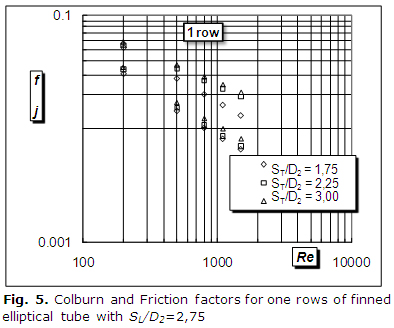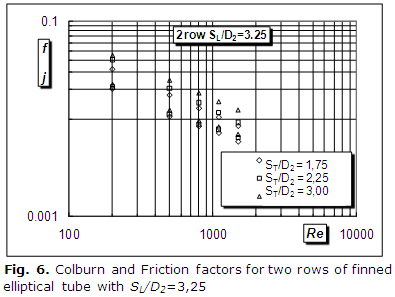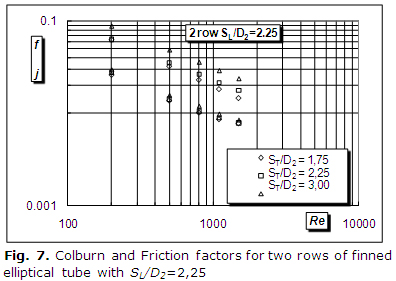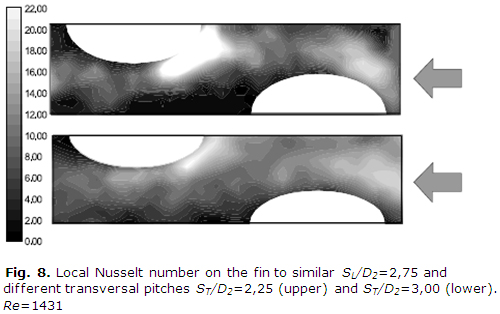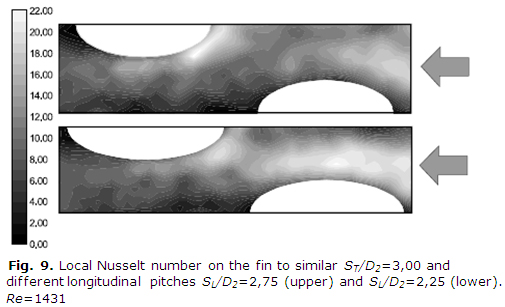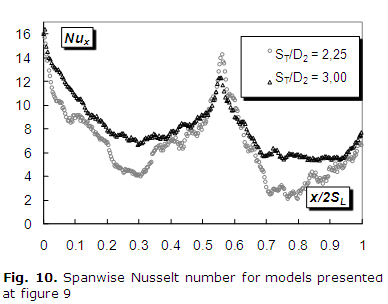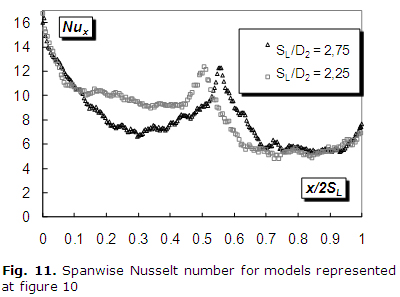Mi SciELO
Servicios Personalizados
Revista
Articulo
Indicadores
-
 Citado por SciELO
Citado por SciELO
Links relacionados
-
 Similares en
SciELO
Similares en
SciELO
Compartir
Ingeniería Mecánica
versión On-line ISSN 1815-5944
Ingeniería Mecánica vol.15 no.3 La Habana sep.-dic. 2012
ARTÍCULO ORIGINAL
Thermal and friction drop characteristic of heat exchangers with elliptical tubes and smooth fins
Caracterización térmica e hidráulica de intercambiadores de calor con tubos elípticos y aletas lisas
Rubén Borrajo-PérezI, Jurandir Ititzo YanagiharaII, Juan José González-BayónI
I Instituto Superior Politécnico José Antonio Echeverría. Centro de Estudio de Tecnologías Energéticas Renovables. La Habana. Cuba.
II University of São Paulo. Department of Mechanical Engineering. São Paulo, Brazil
ABSTRACT
Pressure drop and heat transfer are the most important parameters in compact heat exchanger. There is a lack of information in the literature about heat exchanger with elliptical tube. The objective of this work was the experimental characterization of compact heat exchangers models using elliptical tube with eccentricity of 0,5 and smooth fins. The Reynolds numbers and the spacing were varied and always inside laminar regime. The experiments were conducted in an open wind tunnel using sublimation of naphthalene and the heat and mass transfer analogy. As results, the average and local Nusselt number and friction factor for 36 models were obtained. Correlations for Colburn and friction factors were presented. This correlations were obtained for 200<Re<1500 and isothermal fins. These are the first correlations presented in the open literature covering a wider range of pitches. A baseline for future implementations of enhancement heat transfer techniques is presented.
Key words: friction factor, heat transfer coefficient, elliptical tube, compact heat exchanger.
RESUMEN
Caída de presión y transferencia de calor son importantes parámetros en intercambiadores de calor. Existe falta de información cuando de intercambiadores de calor y tubos elípticos se trata. El objetivo del trabajo fue caracterizar experimentalmente modelos de intercambiadores de calor con tubos elípticos y aletas lisas. El numero de Reynolds y los espaciamientos fueron variados, dentro del régimen laminar. Los experimentos fueron desarrollados en un túnel de viento de circuito abierto usando la sublimación de naftaleno y la analogía calor y masa. Los números de Nusselt medio, locales y el factor de fricción fueron obtenidos en forma de correlaciones de Factores de Fricción y Colburn. Las correlaciones, validas para 200<Re<1500 y aleta isotérmica. Son las primeras correlaciones que se aplican a un tan amplio rango de espaciamientos. Se presenta una línea base para futura comparación en la implementación de técnicas de intensificación de transferencia.
Palabras claves: factor de fricción, coeficiente de transferencia de calor, tubos elípticos, intercambiadores de calor compactos.
INTRODUCTION
Many process involving gas-to-gas or liquid-to-gas heat transfer, with low values of heat transfer coefficients at the gas side, require the determination of the overall heat transfer coefficient with high accuracy. In general, correlations for heat exchangers are very useful for designers but usually these are restricted to a few geometries and arrangements.
Correlations for plate fin compact heat exchanger with staggered round tubes were developed by McQuiston and Gray & Webb apud Webb [1], thelatter being more accurate. These correlations are valid for the following ranges: 2,55≥ST/d0≥1,97; 2,58≥SL/d0≥1,7 and 500<Re<24700. Madi et al [2] carried out and experimental study where 28 heat exchangers samples with plain and corrugated fins were tested. They presented correlations for the prediction of Colburn factor j and the f factor with higher accuracy than earlier correlations, being valid for a larger range of the geometrical parameters. The elliptical tube geometry is one of the most studied non circular arrangement, however, the information about these is not complete because of the large number of parameters affecting the performance of the heat exchanger using this geometry. Brauer apud Webb [1] and M. P. Ximenes in its PhD thesis in 1981 developed in Sao Jose dos Campos Brazil, were the first to study this kind of geometry, comparing its performance to the round one. Bordalo & Saboya[3] focused their work in the hydraulic performance of heat exchangers with one and two rows of tubes using a plain finned elliptical tube with the same pitches than those tested by Ximenes in 1981.
Sohal and O'Brien [4] carry out and numerical and experimental work where circular and oval tubes were investigated and, among others results, they presented the local and average heat transfer coefficients for one finned tube having smooth fin surface. Burkova et al. [5], made a wide study for oval tubes in staggered distribution and looking for the influence of the rows number. It was conducted following the classical method of complete simulation and the Reynolds numbers employed were in turbulent regime of flow.
Enhancement heat transfer is a mean for save energy and materials. Vortex generators (VG), among others techniques, has been occupying an important space in this field. Jacobi and Joardar [6] obtained heat transfer enhancement up to 44 % with lower pressure penalty for compact heat exchangers using in air-cooling and refrigeration applications. A group of parameters related with vortex generators are being investigated, length, height and angle of attack. M. Zeng [7] et all have developed a numerical study of the influence of these parameters, optimized by Taguchi method, on the hydrodynamics and heat transfer characteristic. Two optimal configurations were obtained. During investigations in this area, different approach have been applied. Digital particle image velocimetry (DPIV) as visualization technique was used by Unal & Atlar [8] to investigate the flow pattern on the near-wake of a circular cylinder. The effect of vortex generators on this area was demonstrated.
The VG have been used not only in heat exchangers but also in channel [9] combined to wedge ribs. The Nusselt number and friction factor values obtained from combined the ribs and the WVGs are found to be much higher than those from the ribs or vortex generators used alone.
In other work, Lei et al [10] VG were used in a finned circular tube with two rows. The authors found the j-factor to increase by 35.1-45.2 % with a corresponding increase of 19.3-34.5 % in the friction factor. The better location of VG were not coincident with previously consulted results [11]. Drag reduction was a target of another work [12] where VG where used combined to a bluf-body and significant reduction of pressure drop was obtained.
The small number of correlations for non circular arrangement and their narrow scope of validity are the most important limitations found in the bibliography at present. The increasing number of papers dealing with tubes with non circular geometry is an indicative of the importance of this subject. The improvement of thermo-hydraulic performance of compact heat exchanger with finned tube is necessary because of economical and environmental constraints. One way to reach this objective is to use tubes with better hydrodynamic performance and a smaller wake region.
The present work is an experimental study of the thermal and friction performance of scaled models of plate fin heat exchanger with one and two rows of elliptical tubes. The analogy between the heat and mass transfer was used for the average and local Nusselt number determination. The friction factor was evaluated using a weighted method by means of a digital balance. The objective of this work is to obtain the average Nusselt number (Nu) and the friction factor (f) as function of the Reynolds number in laminar regime for 36 heat exchanger models having one or two rows of tubes where the transversal and longitudinal pitches were systematically varied.
The importance of this study lays in the necessity of make a good prediction of heat transfer and pressure drop behavior for heat exchangers with finned elliptical tube in the stage design. Additionally, the smooth characterization of this heat exchanger will be useful in future investigations as a baseline to calculate the effect of any enhancement technique applied.
MATERIALS AND METHODS
The experiments were conducted in an instrumented open circuit wind tunnel consisting of a contraction at the inlet, a test section, a centrifugal fan and a discharge tube. A flow straightener was located before the test section to guarantee uniformity in the velocity profile at model front.
The test section was build in such a way to permit a rapid and easy access to the model. The wind tunnel should be open circuit when naphthalene sublimation technique is used. A thermometer with a resolution of 0,1 ºC was placed in the rear part of tunnel to measure the temperature of the air flow. The flow rate was measured by means of a vortex flow meter with 1 % of uncertainty. Finally, an electronic balance of high resolution having an RS-232 was used to weight the test specimen before and after each experimental run. A chronometer was used for measuring time.
The pressure measurement was carried out by developing a novel weighting method. It consists of a tube with a pressure tap at one end and the other end submersed in a beaker containing oil. The beaker is placed on the plate of the scale. The general arrangement of the system is shown in the figure 1. The pressure difference, due to the flow losses, produces the elevation of the liquid inside the tube, making lower the scale reading. The relation between this reading and the pressure difference is called the manometer constant and can be obtained manipulating the equations of hydrostatic [13].
Each set of measurement was processed beginning with the calculation of the mass transferred during the test (Δm), obtained by the difference between the initial and the final weight of the specimen (mi and mf) and considering also the mass lost by natural sublimation Δmns:
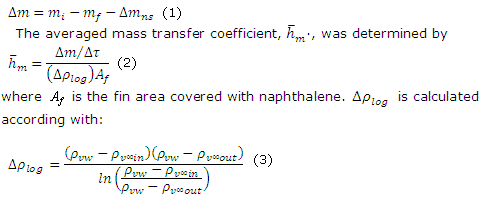
where the density of vapor at the fin surface level (ρvw) is calculate using the ideal gas law at the surface temperature. The vapor pressure of naphthalene is obtained by means of Ambrose's correlation. The vapor density of the mainstream ![]() at the exit of the channel was calculated using the equation 4.
at the exit of the channel was calculated using the equation 4. ![]() is considered null because the wind tunnel is open circuit.
is considered null because the wind tunnel is open circuit.
The denominator of equation 4 is the volumetric air flow rate in the channel, between two consecutive fins. Therefore, the mass Stanton number could be determined by the equation 5:
where u is the average velocity in the minimum free flow area of the channel. From the analogy between the heat and mass transfer we could write:
![]() (6)
(6)
where St
The Reynolds number was calculated using the definition of hydraulic diameter [13]. The Nusselt number was calculated by the equation 8.
The friction factor was calculated by the equation 9, where Δp is the pressure drop produced by the model, p is the air density and Lch the channel length. An area correction was used to normalize the friction factor.
where Aff is the frontal fin area of model and Af is the frontal area of model. The pressure drop through the model is obtained by the following manometer equation. Where Δmp is the scale reading, g is the acceleration of the gravity and the rest are areas defined in the figure 2.
 (10)
(10)
The experimental technique and the procedure used in this work were certified by comparison with experimental results available in the literature. figure 3 presents the experimental results by Ximenes and those obtained in the present work for the same transversal pitch. The values were plot using the Sherwood number (Sh) to avoid the possible divergence introduced by the exponent of the heat and mass transfer analogy and the Schmidt number.
For the pressure drop, figure 4 presents the loss coefficient K, calculated by Bordalo & Saboya[3] for two row of elliptical tubes and the same parameter for the present work (same longitudinal and transversal pitches are considered). The agreement is good, with the differences averaging 5,42 %. This value is lower than the experimental uncertainty. The Reynolds number (Re) is based on the channel height and front velocity. In general, the present results are in good agreement with previous works, although some deviations can be noted at lower Reynolds number, in which the uncertainties is higher for both referenced works. When both of figures (Fig. 3 & Fig. 4) are examinated can be said that the present results are matching with the previous experiments if thermal and pressure drop are considered.
The local Nusselt number was determined by means of an evaporation technique based in the mass transfer analogy. It is based in the change of color suffered by a surface, where wet chalk was previously spread, and a dried process is established. This surface is used to substitute a portion of the fin in a compact heat exchanger model and it is placed in the wind tunnel. The air flowing throughout the heat exchanger passage produces the water evaporation and subsequently the mentioned change of color. The difference in the color of any point of the surface is obtained by computer manipulation of the bitmap file resulting from successive black and white snap of the surface. A previous calibration is made to obtain the local mass transfer-gray scale coef. (C):
 (11)
(11)
where mi and ci are the mass of water evaporated and the value of the gray scale change at a point of the surface. N is the number of point defined over the surface. The equation 12 calculates the local rate of mass transfer per unit area, where t is the time elapsed between two consecutive snaps and Aplaca is the surface area.
where the concentration at surface (ρw) can be calculated by the state equation. The concentration in the flow of air over the surface at the coordinate ![]() in agreement with the conservation equation, is given by the equation 14, considering the area up to the coordinatex, (Ax), and the flow concentration at entrance of the passage
in agreement with the conservation equation, is given by the equation 14, considering the area up to the coordinatex, (Ax), and the flow concentration at entrance of the passage ![]() .
.
where ![]() is calculated integrating on fin area. Additional information about the evaporation technique can be found in the Phd thesis "Experimental analysis of heat transfer enhancement in compact heat exchangers with elliptical geometry using vortex generators" developed by the author in Sao Paulo University Brazil, 2001.
is calculated integrating on fin area. Additional information about the evaporation technique can be found in the Phd thesis "Experimental analysis of heat transfer enhancement in compact heat exchangers with elliptical geometry using vortex generators" developed by the author in Sao Paulo University Brazil, 2001.
The uncertainty analysis was carried out and the results indicated an uncertainty of 6 % for the average Nusselt number, 7 % for the local Nusselt number and 10 % for the friction factor, both uncertainties with 95 % of confidence level.
RESULTS AND DISCUSSION
Figure 5 presents the experimental results for models with one row. The figure presents a log-log plot of the Colburn and friction factor for only three different ST/D2 values; the rest of ST/D2 (2,00; 2,50; 2,75) is not presented to avoid visual confusion in the graphics.
The results of models having two rows of finned elliptical tubes are presented in the figure 6 and figure 7 for the extreme SL/D2 values of 3,25 and 2,25 and to the same values of ST/D2 already presented for one row models.
The observation of figure 5 to figure 7 indicates the influence of the transversal and longitudinal pitches and the number of rows on the thermal performance of heat exchanger models with finned elliptical tubes. The increase of the dimensionless transversal pitch produces an increment of the Colburn factor.
This behavior happens due to higher values of the Nusselt number. This is possible only if the heat transfer coefficient grows, because the hydraulic diameter decreases as the transversal pitch is increased. This phenomenon could explain the small sensitivity to heat transfer when ST/D2 is augmented. Although the tendency was similar for models with one or two rows, it was observed a larger sensitivity in the first case. The increment in the average heat transfer coefficient is possible when ST/D2 is higher, because of the smaller length of the models and the gradual reduction of wake region when the tube diameter is reduced. This is more significant for one-row models, considering the higher value of the mean heat transfer coefficient over the channel. It is also necessary to consider the higher velocities present in the channel when Dh is lower for the same Reynolds number.
The figure 8 shows the local Nusselt number distribution on the fin of two models with the same longitudinal pitch and different transversal pitch. The arrows are indicating the flow direction. The vortex system in the front of the second row tube is stronger for the model with the smaller ST/D2 because of larger diameter of tube; however the bigger length of these models produces a lower average Nusselt number. Is noted too a minor wake area for the models with smaller diameter.
Diminishing the longitudinal pitch has a positive impact on the heat transfer behavior, producing an increment of the Nusselt number by reducing the total fin length. In this case the hydraulic diameter grow when the length is reduced. At the same time, the heat transfer coefficient increases and both have a large influence on the variation of the Nusselt number with SL/D2. The figure 9 is showing the local Nusselt number on the fins of two models with the same adimensional transversal pitch and two values of the longitudinal pitch. The model with the smaller adimensional longitudinal pitch show a higher average Nusselt number, predominant clearer areas are noted in the lower picture. Should be remembered that the length of these models is smaller than presented in the upper picture.
The spanwise Nusselt number for the models compared in the figure 8 and figure 9 are presented in the figure 10 and figure 11. Could be observed the mentioned stronger peak of heat transfer in front of the second row for the models with ST/D2=2,25 and the influence of the developing thin layer for the models with the smaller lengths.
In table 1 are presented the global Nusselt numbers obtained by both of techniques used in this work showing the small deviation for the two models compared.
The friction factor has the same behavior of the Colburn factor as far as the pitch variation is concerned. When the transversal pitch is augmented the friction factor f increases because the relation Dh/L also increases and its effect is predominant over the friction factor, despite the fact that the pressure drop diminishes with ST/D2. When the influence of SL/D2 is analyze, a reduction of the friction factor is observed the increasing of longitudinal pitch. In this case, the diminishing of the relation Dh/Ltroc is determinant despite the higher pressure drop caused by larger fins. Finally the influence of the row number could be analyzed by comparison of the figure 5 and figure 7 corresponding to one and two rows models having the same transversal and longitudinal pitches. It was noted an approximation between their behaviors for the highest Reynolds numbers. On the other hand, the models with one row of tubes have a better thermal performance when the velocities are low (note a more negative slope of j vs Re plotted in Fig. 5 when compared to Fig.7). The growing importance of the vortical system and a minor contribution of the boundary layer in the second row of models having two rows is the reason for the improvement of the thermal performance when the velocity grows. The absence of vortical system in one row model affects its performance at higher velocities.
Using approximately six hundred experimental values obtained in this work, correlations for friction and Colburn factor were determined. The correlations, presented below, were obtained using the Mathcad software and they are valid for 200≤Re≤1500; 1,75≤ST/D2≤3,00; 2,25≤SL/D2≤3,25 and isothermal fin.
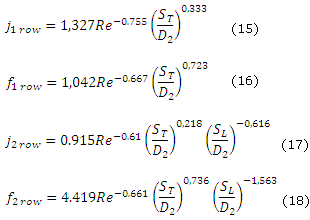
CONCLUSIONS
The thermal and friction characterization of thirty-six models (six with one row) of compact heat exchanger with finned elliptical tubes was carried out. The effects resulting from variations of the transversal and longitudinal pitches in a wide range were analyzed. The Nusselt number was found increasing when the transversal pitch is augmented or the longitudinal pitch is diminished and the causes of this behavior were analyzed. The horseshoe vortex system generated in front of the tubes and the developing boundary layer were the mechanisms responsible for the heat transfer enhancement. A novel technique for pressure measurement was developed and certified during this work. The average Nusselt number behavior was studied by measurement of local Nusselt numbers on the fin. A group of simple empirical correlations were obtained considering the influence of the Reynolds numbers the longitudinal and transversal pitches. These correlations for compact heat exchangers with one and two rows of elliptical tubes, considering smooth fin and isothermal condition, were never presented before. A baseline to compare the performance of smooth configuration with enhanced configuration is now available.
REFERENCES
1. Webb, R. L. Principles of Enhanced Heat Transfer. 1st ed. New York: John Wiley & Sons. 1994. 452 p. ISBN 10 0471577782.
2. Madi, M., Jonhs, R. y Heikal, M. "Performance Characteristics Correlation for Round Tube and Plate Finned Heat Exchangers". International Journal of Refrigeration. 1998, vol. 21, nº 7. p. 507-517. ISSN 0140-7007.
3. Bordalo, S. and Saboya, F. E. "Pressure Drop Coefficient for Elliptical and Circular Sections in One, Two and Three-row Arrangements of Plate Fin and Tube Heat Exchangers". Journal of the Brazilian Society of Mechanical Science. 1999. vol. 21, nº. 4. p. 600-610. ISSN 1678-5878.
4. Sohal, M. S. and O'Brien, J. E. "Improving Air-Cooled Condenser Performance Using Winglets and Oval Tubes in a Geothermal Power Plant". Geothermal Resources Council Transactions. 2001. vol. 25. p. 234-238. ISSN 0193-5933.
5. Burkova, V. K., Medvedskiia, V. P., Kochegarovaa, I. Y. et al. "Studies of Heat Transfer and Aerodynamics in Bundles Assembled from Oval Tubes". Thermal Engineering. 2010. vol. 57, nº 3. p. 227-231. ISSN 0040-6015.
6. Joardar1, A. and Jacobi, A. M. "Heat transfer enhancement by winglet-type vortex generator arrays in compact plain-fin-and-tube heat exchangers". International Journal of Refrigeration. 2008. vol 31. p. 89-97. [Consulted in april 16 of 2012], Available in: http://www.elsevier.com/locate/ijrefrig. ISSN 0140-7007.
7. Zeng, M., Tang, L. H., Lina, M. et al. "Optimization of heat exchangers with vortex-generator fin by Taguchi Method". Applied Thermal Engineering. 2010. vol. 30. p.1775-1783. [Consulted in april 20 of 2012], Available in: http://www.elsevier.com/locate/apthermeng. ISSN 1359-4311.
8. Unal, U. O. and Atlar, M. "An experimental investigation into the effect of vortex generators on the near-wake flow of a circular cylinder". Experimental Fluids. 2010. vol. 48. p. 1059-1079. [Consulted in may 20 of 2012], Available in http://www.sciencedirect.com/science/journal/07351933. ISSN 0723-4864. DOI 10.1007/s00348-009-0791-6.
9. Chompookham, C., Thianpong, S., Kwankaomeng, P. et al. "Heat transfer augmentation in a wedge-ribbed channel using winglet vortex generators". International Communications in Heat and Mass Transfer. 2010, vol. 37. p. 163-169. ISSN 0735-1933
10. Lei, Y. G., He, Y. L., Tian, L. T. et al. "Hydrodynamics and heat transfer characteristics of a novel heat exchanger with delta-winglet vortex generators". Chemical Engineering Science. 2010. vol. 65. p. 1551-1562. [Consulted in may 21 of 2012], Available in: http://www.elsevier.com/ces. ISSN 0009-2509.
11. Pérez, R. B., Cabrera, D. Q. and González, J. J. "Análisis Exergético Comparativo entre Intercambiadores de Calor". Ingeniería Mecánica. 2012. vol. 14, nº. 3, p. 181-188. ISSN 1815-5944.
12. Aider, J. L., Beaudoin, J. F. and Wesfreid, J. E. "Drag and Lift Reduction of a 3D Bluff-body using Active Vortex Generators". Experimental Fluids. 2009. DOI 10.1007/s00348-009-0770.
13. Pérez, R. B. "Medición de caída de presión en túneles de viento por método alternativo". Ingeniería Energética. 2008. vol. 29, nº. 3. p. 30-36. ISSN 1815-5901.
Recibido: 6 de enero de 2012.
Aceptado: 23 de julio de 2012.
Rubén Borrajo-Pérez. Instituto Superior Politécnico José Antonio Echeverría. Centro de Estudio de Tecnologías Energéticas Renovables. La Habana. Cuba.
Correo electrónico: rborrajo@ceter.cujae.edu.cu













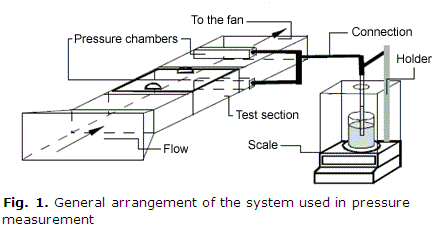
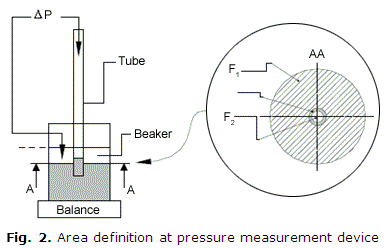
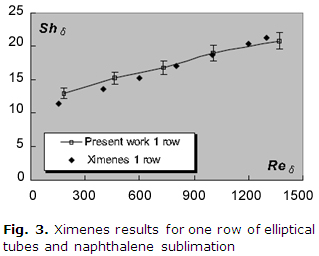
![Fig. 4. Friction results of Bordalo & Saboya[3] for one row of elliptical tubes](/img/revistas/im/v15n3/f0408312.jpg)
 (12) and (13)
(12) and (13)
